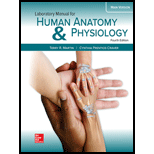
Concept explainers
Muscles that move the thigh at the hip joint have origins on the
a. pelvis.
b. femur.
c. tibia
d. patella.
Introduction:
Lower limb consists of the largest muscles. Most muscles that act on femur originate on the hipbone.
Answer to Problem 1PL
Correct answer:
The correct answer is option (a) Pelvis.
Explanation of Solution
Explanation/justification for the correct answer:
Option (a) Pelvis. The muscles that move the thigh at the hip joint have their origins on the pelvis. Those muscles attached on the anterior pelvis act to flex the thigh at the hip joint, those attach at the posterior pelvis act to extend the thigh at the hip joint, those attached at the lateral side of the pelvis act as abductors and rotators of the thigh at the hip joint, and those attached on the medial pelvis act as adductors of the thigh at the hip joint. So, the correct answer is option (a).
Explanation for incorrect answer:
Option (b) Femur. Femur is the thigh bone. The muscles that move the thigh at the hip joint originate at pelvis and the insertion I usually on the femur. So, this is an incorrect option.
Option (c) Tibia. Tibia is one of the leg bones. The leg has two bones: a thick strong tibiaon the
medial side and a slender fibula on the lateral side. Tibia and fibula extend from the knee to the ankle. So, this is an incorrect answer.
Option (d) Patella. The patella or kneecap is a roughly triangular sesamoidbone embedded in the tendon of the knee.So, this is an incorrect answer.
Want to see more full solutions like this?
Chapter 25 Solutions
Laboratory Manual for Human Anatomy & Physiology Main Version
- The flexes the knee and causes a slight medial rotation to "unlock" the knee joint. a. sartorius b. soleus c. tensor fasciae latae d. popliteusarrow_forwardPutting It All Together A. Humerus B. Brachialis C. Biceps brachii D. Triceps brachii (long head) E. Triceps brachii (medial head) F. Triceps brachii (lateral head) Lateral Posteriorarrow_forwardA movement of the foot that turns the sole outward or laterally is called a. dorsiflexion. b. inversion. c. eversion. d. plantar flexion.arrow_forward
- The muscle on the calf portion of the leg is the a. gastrocnemius. b. sartorius. c. rectus femoris. d. tibialis anterior.arrow_forwardWhich muscle provides the most control of hip joint movement during the act of sitting? a. iliacus b. semitendinosis c. semimembranosis d. gluteus maximus e. gluteus mediusarrow_forwardWhich of the following does NOT have striated muscles? a. abdomen b. arm c. hamstring d. liverarrow_forward
- This muscle depresses and adducts the eye. a. inferior rectus b. inferior oblique c. lateral rectus d. superior obliquearrow_forwardWhat are the muscles of the pharyngeal arches and derivatives: a. branchiomeric muscles b. none of the above c. somatic muscles d. visceral musclesarrow_forwardWhich of these muscles would you expect to be especially welldeveloped in a boxer known for his powerful jab (punching straightahead)?a. biceps brachii c. trapezius e. supinatorb. brachialis d. triceps brachiiarrow_forward
- 34. Muscles that control the mandible are the A. muscles of the nose. B. muscles of mastication. C. serratus muscles. ____ 35. The connective tissue that holds skull together during infancy is called a suture. A. True B. False ____ 36. Where are the external oblique muscles are located? A. along the sides of the abdomen B. in the calves C. in the buttocksarrow_forwardThe large muscle group that attaches the leg to the pelvic girdle and produces extension of the hip joint is the ________ group.a. glutealb. obturatorc. adductord. abductorarrow_forwardWhich of these muscles does not adduct the arm (humerus)?a. latissimus dorsi c. teres major e. coracobrachialisb. deltoid d. pectoralis majorarrow_forward
 Human Anatomy & Physiology (11th Edition)BiologyISBN:9780134580999Author:Elaine N. Marieb, Katja N. HoehnPublisher:PEARSON
Human Anatomy & Physiology (11th Edition)BiologyISBN:9780134580999Author:Elaine N. Marieb, Katja N. HoehnPublisher:PEARSON Biology 2eBiologyISBN:9781947172517Author:Matthew Douglas, Jung Choi, Mary Ann ClarkPublisher:OpenStax
Biology 2eBiologyISBN:9781947172517Author:Matthew Douglas, Jung Choi, Mary Ann ClarkPublisher:OpenStax Anatomy & PhysiologyBiologyISBN:9781259398629Author:McKinley, Michael P., O'loughlin, Valerie Dean, Bidle, Theresa StouterPublisher:Mcgraw Hill Education,
Anatomy & PhysiologyBiologyISBN:9781259398629Author:McKinley, Michael P., O'loughlin, Valerie Dean, Bidle, Theresa StouterPublisher:Mcgraw Hill Education, Molecular Biology of the Cell (Sixth Edition)BiologyISBN:9780815344322Author:Bruce Alberts, Alexander D. Johnson, Julian Lewis, David Morgan, Martin Raff, Keith Roberts, Peter WalterPublisher:W. W. Norton & Company
Molecular Biology of the Cell (Sixth Edition)BiologyISBN:9780815344322Author:Bruce Alberts, Alexander D. Johnson, Julian Lewis, David Morgan, Martin Raff, Keith Roberts, Peter WalterPublisher:W. W. Norton & Company Laboratory Manual For Human Anatomy & PhysiologyBiologyISBN:9781260159363Author:Martin, Terry R., Prentice-craver, CynthiaPublisher:McGraw-Hill Publishing Co.
Laboratory Manual For Human Anatomy & PhysiologyBiologyISBN:9781260159363Author:Martin, Terry R., Prentice-craver, CynthiaPublisher:McGraw-Hill Publishing Co. Inquiry Into Life (16th Edition)BiologyISBN:9781260231700Author:Sylvia S. Mader, Michael WindelspechtPublisher:McGraw Hill Education
Inquiry Into Life (16th Edition)BiologyISBN:9781260231700Author:Sylvia S. Mader, Michael WindelspechtPublisher:McGraw Hill Education





